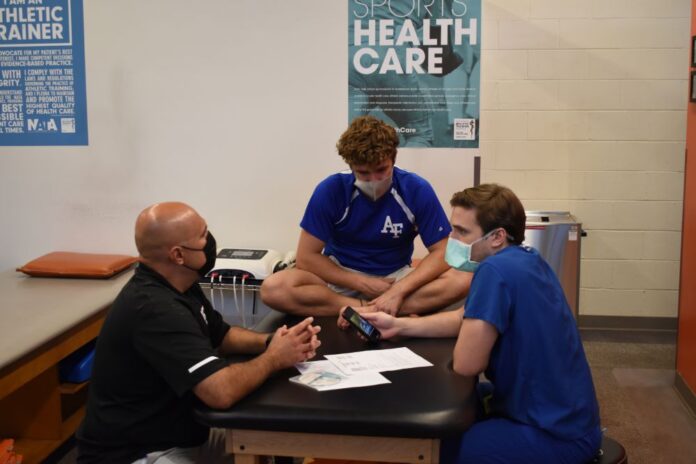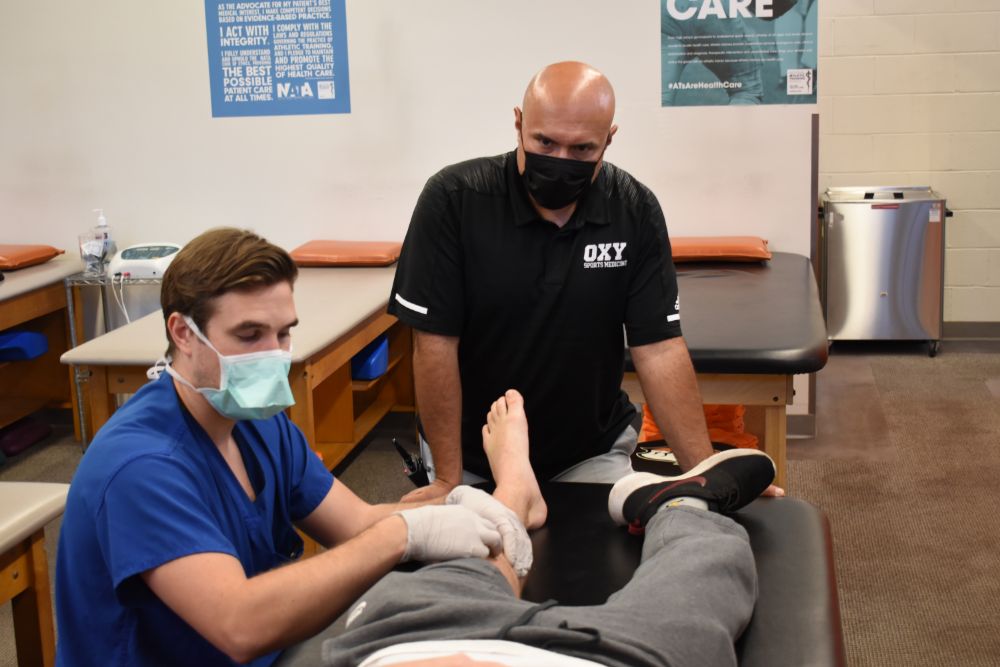
5 a.m.
When Joe Gonzalez — Occidental’s head athletic trainer — arrives on campus, the sun has not yet risen on the college. On a typical day, Gonzalez opens the Culley Athletic Facility, Occidental’s sports medicine training room, between 5–6 a.m. depending on which teams are practicing that morning. On Wednesdays, Gonzalez arrives at 5:15 a.m. to prepare for the women’s basketball practice, which begins at 5:45 a.m., and the swim team’s practice, which begins at 6:00 a.m.
“I’ll cover those practices, I’ll do any treatments that needs to go on,” Gonzalez said. “We also have some teams in the early morning that do weightlifting sessions — their strength sessions. I’m here to help if they have any injuries that need to be tended to.”
Rob Bartlett, head coach for men’s and women’s track & field and cross country teams said the athletic trainers do an incredible job, and are some of the busiest individuals in the athletics department.
“They don’t get an off-season, from the middle of August until the end of May,” Bartlett said. “They do a really good job of providing almost 24/7 care — they’re up very early in the morning, work until late in the night and they work in the weekend.”
According to Brian Gomez, athletic trainer on the sports medicine team in the Occidental Athletics department, the three trainers — himself, Halie Stoltenberg and Joe Gonzalez — are responsible for helping healthy student-athletes prevent injuries, and treating injured student-athletes.
“Sometimes [we tend an injury] that doesn’t necessarily come from practice or a game, it could be when [student-athletes] have turned their ankle walking on the street,” Gomez said.
9 a.m. to noon
Gonzalez said early morning practices all end before 9 a.m. With most student-athletes off to their morning classes, Gonzalez takes on his administrative duties — replying to emails, filing injury reports and making calls to physicians.
Aside from his administrative duties during this time of day, Gonzalez tends to injured athletes. According to Bartlett, the athletic trainers help prevent minor conditions from developing into serious injuries for the student-athletes.

“For instance, [a student-athlete] might have a tight calf muscle, but if we leave it alone, it can become a stress reaction, which can become a fractured bone,” Bartlett said. “I think [the trainers] do an amazing job of making sure those things don’t keep progressing down the line to become too serious.”
Noon
According to Gonzalez, Gomez and Stoltenberg join him at the training facility around noon, in the short time between morning and evening practices. Gonzalez said each trainer serves as the primary athletic trainer for a different set of teams in the fall, winter and spring seasons.
According to Matthew Teplitz (senior) a forward on the men’s soccer team in his fifth year at Occidental, Gomez assisted him virtually in his recovery from hernia surgery in Spring 2020, when Occidental transitioned to remote operations due to the COVID-19 pandemic.
“I was in contact with Brian everyday for rehab stuff and to work through the recovery process,” Teplitz said. “They’re always there for us, whether we’re thousands of miles away, or a five-minute walk [away].”
According to Gomez, before he was furloughed during the pandemic, he provided Teplitz with professional advice on questions to ask the doctor, and recovery steps to help Teplitz get healthy.
According to Gonzalez, student-athletes are hard-working, respectful and appreciative of the sports trainers’ work, which makes their jobs enjoyable.
“When they’re in-season, they’re giving 20-plus hours a week to their sport,” Gonzalez said. “When I see our student athletes putting in that kind of effort into their sport and school, I’ve got to bring my A-game everyday because they’re bringing their A-game everyday.”
After 3 p.m.
Afternoon practices start around 3 p.m., according to Gonzalez. Gomez and Stoltenberg are responsible for taping, examining and treating student-athletes who practice and compete in the afternoons and evenings. Normally, Gonzalez leaves work around 5:30 p.m., while Gomez and Stoltenberg stay until 8 to 9 p.m. On days when there are evening home games, the two trainers may come in later and stay until later to tend to injuries and medical situations that occur during competition, according to Gomez.
According to Gonzalez, the athletic trainers tend to be busier at the start of the season and at seasonal transitions. Gomez said winter break is the only time in the year when their work slows down a bit.
“Basketball is now practicing, swim & dive is now practicing. Those are winter sports. That’s at the same time as our fall sports,” Gonzalez said. “When we get into December, we only have winter sports going on so we’re not as busy. When the spring semester starts up again, we get really busy again.”
After their busy work days, the trainers enjoy spending quality time with their families and taking some time for themselves. Gomez said he enjoys going for walks with his wife and dog and watching the occasional movie, while Stoltenberg said she spends time with her husband and daughter after work, and also enjoys reading books. Gonzalez said once he leaves the training room, he returns to his other full-time job — being a father to his 8-year-old daughter.
![]()


































